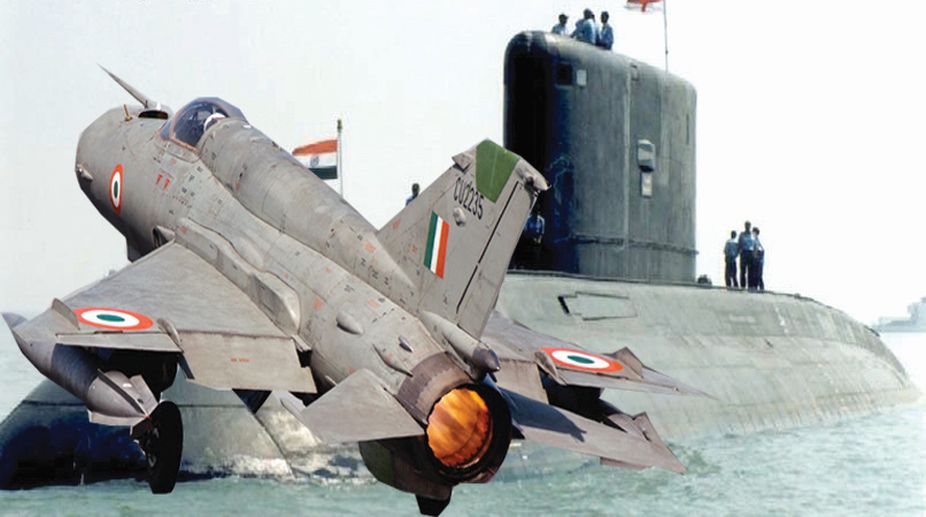Brahmastra veterans meet at Panagarh military station
Under the aegis of the Indian Army’s Eastern Command, Brahmastra Corps organised the Brahmastra Veterans Meet on Sunday at Panagarh Military Station.

Representational Image
Defence analyst Mandeep Singh Bajwa has said, “The army doesn’t have modern assault rifles, steel helmets, bullet-proof jackets and night vision/night firing equipment. In addition to this, we also need to strengthen our Mountain Strike Corps. The Indian army relies mostly on Russian built T-72 and T-90 tanks. The army needs indigenous built tanks to fulfill the gap. Indigenously built Arjun Mark II is still in its trial phase, though this main battle tank has much more superior firepower as compared to Russian tanks. We need artillery guns as our main artillery gun as Bofors has become outdated.”
As far as the Air Force is concerned, the picture is not too bright either. There is a major shortage of fighter jets. Currently we have 33 squadrons of fighter jets, whereas the IAF is authorised 42 fighter squadrons. This figure will reduce further as MiG fighter jets will be decommissioned soon.
Advertisement
The government had signed a deal to procure 126 French fighter jets, Rafale, and 36 of these fighter jets will be delivered by 2019 in the ‘ready to fly’ condition and the remaining 90 will be manufactured in India by Hindustan Aeronautical Ltd. The induction of indigenous built Tejas will also narrow the gap, but this aircraft needs improvement to match the requirements of IAF which is also thinking of buying American fighter jets F-16 or Sweden’s Gripen to increase its strength.
Advertisement
There is a tremendous shortage in the allocation of capital expenditure to the Air Force. Even if we induct more aircraft, we don’t have proper infrastructure to keep them. According to defence analysts, “Runway resurfacing needs to be done, aircraft hangers need to be built, and this requires a lot of funds. The work is getting stalled due to the lack of funds. Minimum Rs 700-800 crore is needed to build proper infrastructure. We have a bigger carry-over liability in 2018-2019, so the works are going to be stalled.”
The picture is equally gloomy in the Indian navy. There is a shortage of submarines. We have currently 14 submarines in operation; half of them have completed 75 per cent of the service. INS Kalvari has been commissioned into the navy under Project-75 and five more submarines will be inducted under the same projection in the coming years. We need to have at least 24 submarines. Currently we have only one aircraft carrier along the western coast, but we need another aircraft carrier along the eastern coast. If we want our navy to be a ‘Blue water Navy’, attention needs to be paid on its modernisation.
Construction of 12 mine counter-measures vessels are also pending at Goa Shipyard Limited (GSL). There has been a delay in importing 16 medium multirole helicopters of 12 tonne each. Our navy requires a replacement of obsolete the Cheetah helicopters.These are some of the major requirements by the three wings of our defence forces. These deficiencies must be addressed on a war footing and priority must be given to modernisation of our defence forces lest we are caught with our pants down like in 1962.
More worryingly, the allocations made for maintenance of equipment currently in use is also inadequate. Similarly, allocation towards war wastage stock, including ammunition stock, is largely the same as last year. In addition to the focus on “Make in India” in defence, it is expected that indigenous design and development be undertaken by the Indian industry for producing vital components. Since its introduction, no development project has been signed. It has been allocated a paltry Rs. 44.63 crore in assistance. This year’s budget is also silent on policy issues like the strategic partnership scheme and defence technology fund.
The Defence budget cuts have affected modernisation of the armed forces. However, before the Ministry of Defence can ask for more funds, it needs to address the issue of underutilisation of the capital budget. One major issue is the expenditure on modernisation.
This expense is not fully utilised every year. A sum of nearly Rs 6000 crore was surrendered in the financial year 2016-17. As per the estimates, approximately Rs 7000 crore worth of the capital budget has been surrendered from the 2017-18 capital expenditure. This year we are focusing on full utilisation of the modernisation expenses. In this case, the finance ministry is being blamed as underutilisation of the capital budget is due to the finance ministry’s machinations, which prevent big contracts from getting approved.
The defence outlay has been receding every year, but for 2018-19 it has been the lowest ~ 1.58 per cent of the GDP since 1962. This is a matter of grave concern for the armed forces. The standing committee of defence analysts had recommended that the defence outlay for its modernisation should be 2.5 to 3 per cent of the GDP. This outlay is said to be under allocation. This has serious implications for battle worthiness of the forces.
In contrast to other democracies, India spends the least on defence and national security. This calls for serious strategic analysis at the highest level. President Trump has announced plans to increase the US defence budget in 2018 by $54 billion in order to “rebuild the depleted military of the United States of America at a time we most need it”. According to the Stockholm International Peace Research Institute, in 2015 US defence spending outstripped that of China, Russia, UK, France, Japan, Saudi Arabia and India combined. India needs a strong army if it wants to face its adversaries with strength and dignity.
The writer is a retired Professor of International Trade. He can be reached at vasu022@gmail.com
(Concluded)
Advertisement